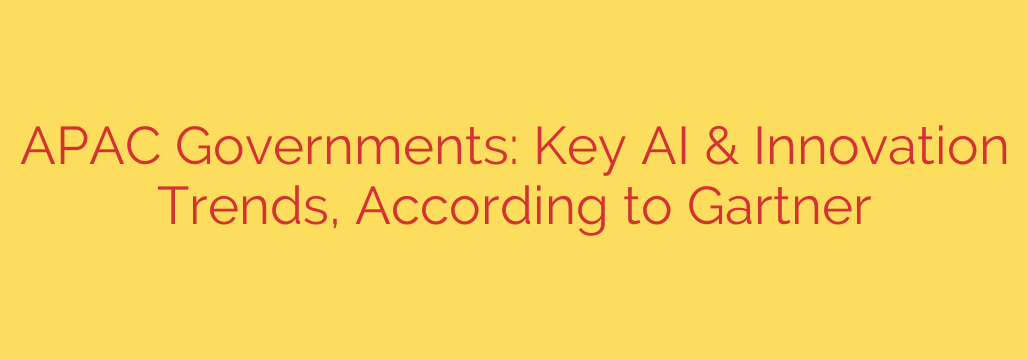
Navigating the Future: 5 Critical Technology Trends for APAC Governments
Governments across the Asia-Pacific region are at a critical juncture, facing rising citizen expectations for seamless digital services and an increasingly complex security landscape. To meet these challenges head-on, public sector leaders are embracing a wave of technological innovation. This digital transformation is not just about adopting new tools; it’s about fundamentally rethinking how public services are designed, delivered, and secured.
Here are five key trends shaping the future of governance and public administration in the APAC region.
1. The Shift to Adaptive Security
The old model of cybersecurity—building a digital fortress to keep threats out—is no longer sufficient. Today’s sophisticated and persistent threats require a more dynamic approach. This has led to the rise of adaptive security, a strategy built on prediction, prevention, detection, and response.
Instead of a one-time verification process, an adaptive security model operates on the principle of continuous risk and trust assessment. This means that security systems are constantly monitoring user behavior, data flows, and system activity to anticipate and mitigate threats in real-time. For government agencies handling sensitive citizen data, this proactive and flexible approach is no longer an option but a necessity.
Actionable Tip: Public agencies should invest in security frameworks that can adapt to changing threat levels, incorporating elements like behavioral analytics and AI-driven threat detection to stay ahead of malicious actors.
2. Building Unified Digital Identity Ecosystems
Fragmented, siloed identity systems are a major source of friction for citizens and a security risk for governments. The solution lies in creating unified digital identity ecosystems, where a single, secure digital ID can be used to access a wide range of public and private sector services.
Imagine a citizen using one secure credential to file taxes, access healthcare records, renew a driver’s license, and even open a bank account. This not only improves citizen convenience and trust but also enhances security by centralizing and strengthening identity verification. Governments leading in this area are creating platforms that are secure, privacy-preserving, and interoperable, setting a new standard for citizen-centric service delivery.
3. Embracing the Total Experience (TX) Strategy
Excellent public service is about more than just a slick website or a user-friendly app. Total Experience (TX) is a comprehensive strategy that links citizen experience (CX), employee experience (EX), and user experience (UX) to achieve better outcomes for everyone.
The core idea is simple: empowered employees with efficient, modern tools deliver a better experience to the citizens they serve. When a government agency invests in improving its internal processes and providing its staff with effective technology, the result is a virtuous cycle of satisfaction and efficiency. TX requires breaking down internal silos and designing services holistically, considering every touchpoint for both the public and the public servant.
4. Leveraging AI for Advanced Decision Intelligence
Artificial intelligence in government is maturing beyond basic automation and chatbots. The next frontier is decision intelligence, which uses AI and machine learning to augment and improve human decision-making.
Instead of replacing human experts, AI can analyze vast datasets, model potential outcomes, and identify complex patterns that humans might miss. This empowers public sector leaders to make more informed, evidence-based decisions in areas like policy creation, budget allocation, and crisis management. From predicting infrastructure needs to optimizing emergency response routes, AI-powered decision intelligence is becoming a crucial tool for effective and proactive governance.
5. Accelerating the Modernization of Legacy Systems
Many of the most exciting innovations in government technology are held back by one significant obstacle: outdated legacy systems. These aging, monolithic systems are often inefficient, expensive to maintain, and highly vulnerable to security breaches.
Recognizing this, forward-thinking agencies are accelerating their migration to flexible, scalable, and cloud-native architectures. This foundational modernization is essential for enabling other key trends like adaptive security and AI. By replacing rigid legacy infrastructure with agile, modular platforms, governments can innovate faster, respond more effectively to changing needs, and build a resilient technological foundation for the future. This is the critical groundwork that makes all other digital progress possible.
By strategically embracing these five trends, governments across the APAC region can build more responsive, resilient, and trusted public services for the years to come.
Source: https://datacenternews.asia/story/gartner-highlights-key-ai-innovation-trends-for-apac-governments








